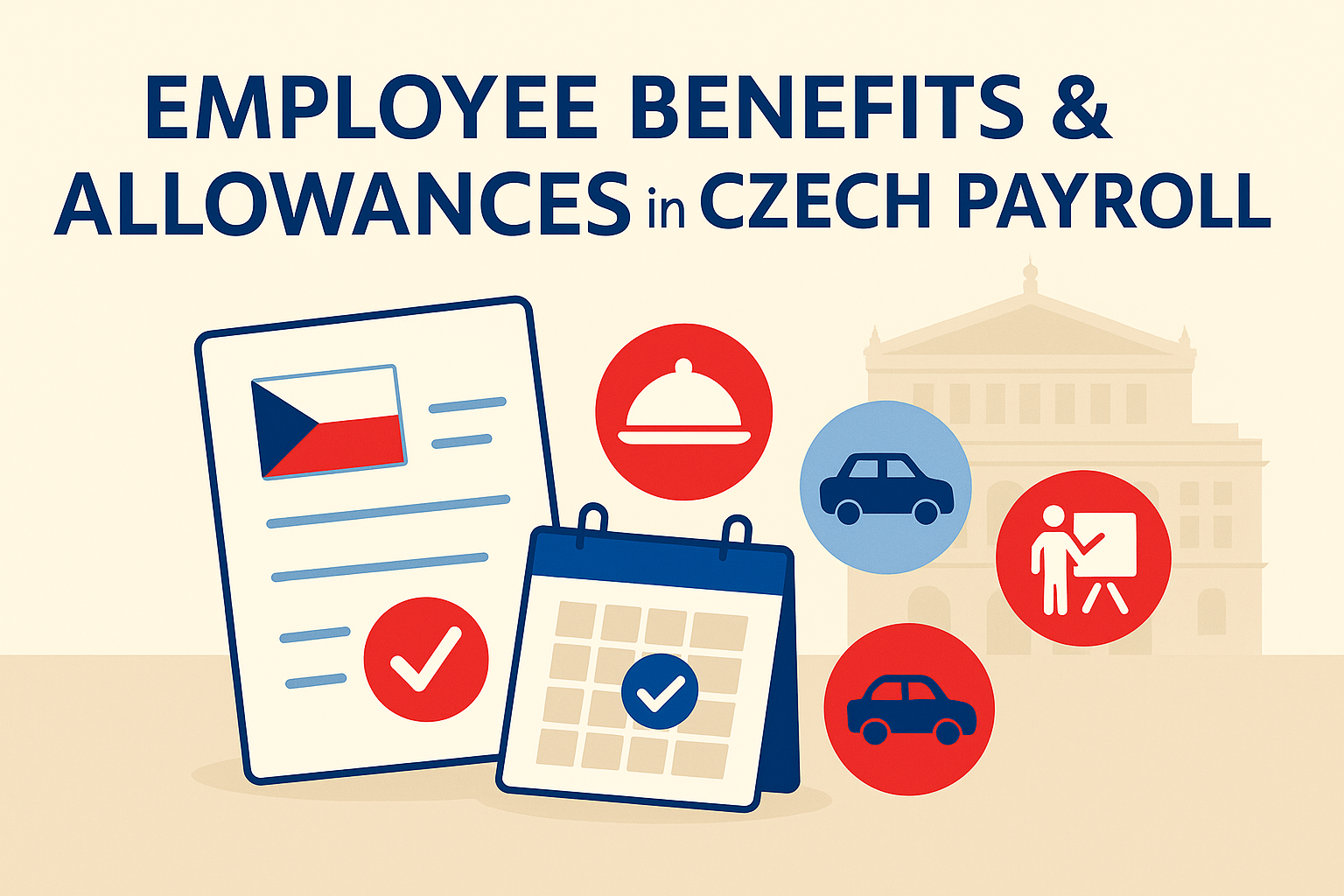Czech employee benefits are treated in payroll according to whether they are statutory reimbursements, taxable perks, or documented business expenses. This guide explains the payroll impact, tax treatment, and the documentation you should keep.
1) How Czech payroll treats benefits and allowances
In the Czech payroll context, benefits and allowances split into three practical groups: (a) statutory reimbursements and allowances (typically tax-exempt within legal rules), (b) non-cash or cash benefits that may be partially exempt or fully taxable, and (c) business expenses that should not enter payroll at all when reimbursed against proper documentation. Getting the categorisation right prevents under/over-taxation and avoids insurer/tax corrections.
2) Statutory reimbursements (generally tax-exempt within limits)
- Business travel reimbursements: per diem/meals, accommodation, mileage or public transport — tax-exempt if paid per the Labour Code and supported by travel orders and receipts.
- Work-related medical checks & mandatory training: employer-paid statutory checks/certifications are not taxable income for the employee.
- Remote-work/operational expenses: when reimbursing demonstrable work expenses under an internal policy, amounts are typically outside taxable income (keep documentation and caps aligned with law/policy).
3) Common benefits — taxable vs. exempt (payroll view)
| Benefit / Allowance | Typical Payroll Treatment | Payslip / Reporting Notes |
|---|---|---|
| Meal support (vouchers/cards) | May be tax-advantaged within statutory limits; excess is taxable income. | Show taxable portion in gross; track exempt portion under a non-taxable row if your payslip format supports it. |
| Transport subsidy / commuting | Usually taxable if it is a general perk; specific documented business travel remains tax-exempt. | Separate regular commuting benefit (taxable) from business travel reimbursement (exempt). |
| Company phone/laptop for work | Business use is not taxable; non-negligible private use can be treated as taxable benefit. | Keep an internal policy on acceptable private use; document asset assignment. |
| Training / language courses | Job-related training is not taxable; purely personal courses are taxable. | File training purpose and manager approval; keep vendor invoices. |
| Medical / sport / culture benefits | Tax treatment depends on instrument and legal limits; beyond limits usually taxable. | Use a benefits platform or ledger to track annual limits per employee. |
| Home-office allowance / remote-work reimbursement | Non-taxable when paid as a statutory per-hour flat rate or as a documented reimbursement linked to actual work costs under an internal policy. Taxable if paid as a general monthly cash stipend unrelated to hours or costs. | Keep records: written remote-work agreement, eligible hours, applied rate, receipts/policy. On the payslip, show non-taxable reimbursement separately from any taxable cash allowance. |
| Company car (private use) | Taxable non-cash income per statutory methodology (value-in-kind). | Maintain car assignment records; reflect value-in-kind on the payslip. |
4) What should not be processed as taxable payroll
Ensure teams distinguish between a benefit and a business expense. Properly documented business costs (e.g., client lunches, business travel, work tools) are company expenses reimbursed outside the taxable payroll base. Use clear expense policies, receipt requirements, and cost-centre routing to prevent accidental payroll taxation.
5) Controls to add before month-end close
- Classification check: benefit vs. reimbursement vs. business expense — verify ledger mapping before payroll cut-off.
- Limits & caps control: annual/monthly caps (e.g., meal support, wellness budgets) and split taxable/exempt portions.
- Documentation control: travel orders, receipts, asset handover forms, internal approvals.
- Payslip clarity: separate taxable vs. non-taxable rows; keep descriptions understandable for employees.
- Vendor coordination: align HRIS/benefits export with payroll import — fields, codes, and period mapping.
6) Practical example scenarios
- Hybrid employee with meal support and remote-work reimbursement: part of meal support may be tax-advantaged within limits; remote-work reimbursement stays outside taxable income if policy-based and documented.
- Remote-work reimbursement vs. cash allowance: documented home-office costs or a statutory per-hour flat rate are non-taxable; a general monthly “home-office stipend” without linkage to hours/costs is taxable income.
- Training budget: job-related course is not taxable; a personal hobby course is taxable and should appear in gross income.
Need a clear, practical handbook?
Get the Czech Payroll Guide — plain-English rules, worked examples, and month-end controls to keep benefits and allowances compliant.
Disclaimer: This article provides general information. Always confirm current limits and legal definitions before payroll close; tax and insurance rules may change.
